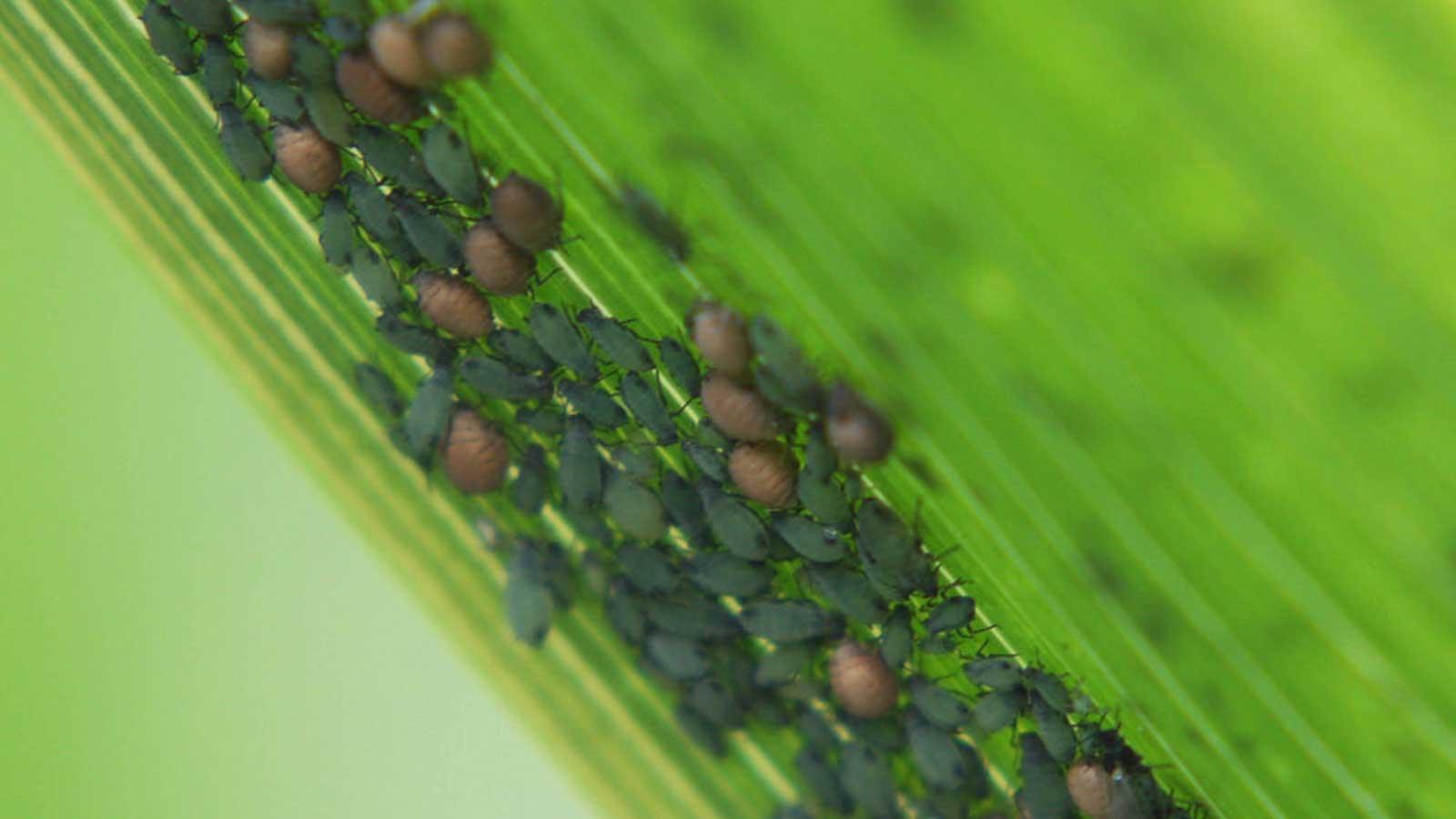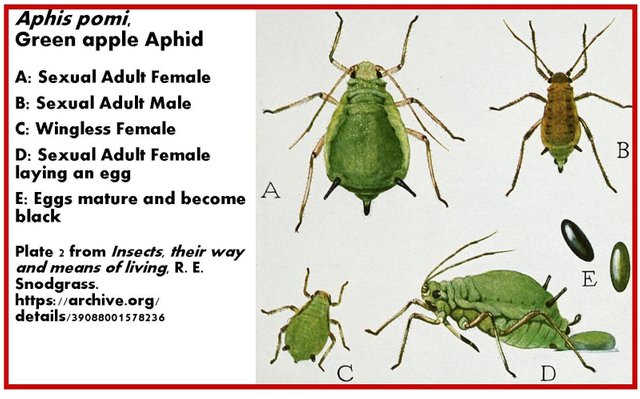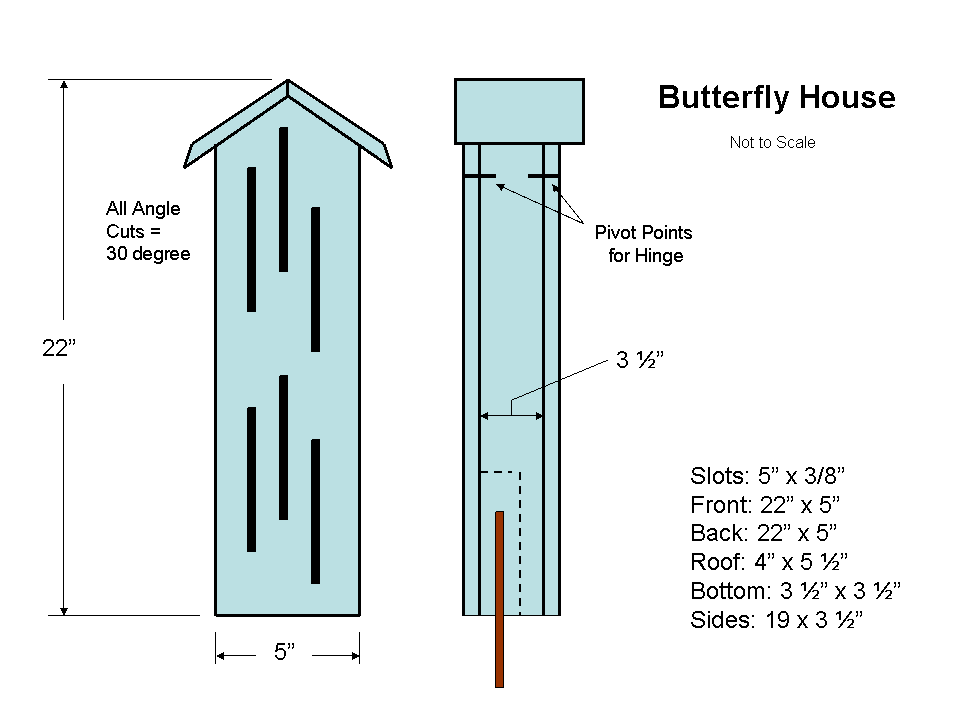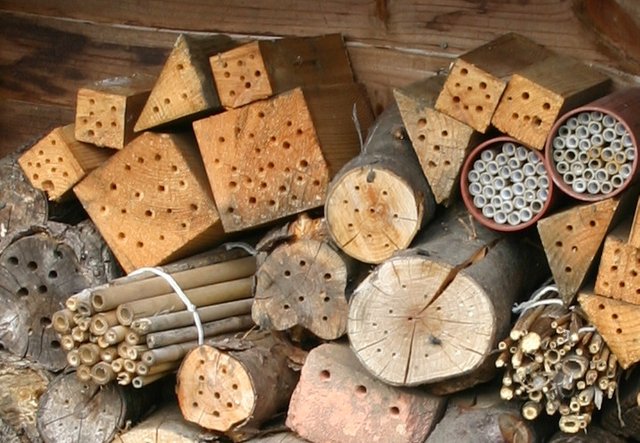Annoying Aphids: All About Aphididae And How To Eliminate Them
Oh, do I ever hate aphids. These little pesky insects suck the life out of my plants (quite literally!), and wherever they go, they bring plant destruction in their wake. Their presence causes even more disastrous problems to occur to my garden.
But there's a way to eliminate aphids from your landscape, and by keeping on top of the problem, you can keep them away for years to come. Today, I'll tell you everything you need to know about these tiny pests, how to treat problems that they cause, and how to get them out of your garden for good!

Aphid Overview
- Common Name(s) Aphids, plant lice, greenflies, blackflies, whiteflies, rose aphids, potato aphids, bean aphids, cabbage aphids, green peach aphids, wooly aphids, wooly apple aphids, melon aphids, lettuce root aphids, plus many more
- Scientific Name(s) Over 4400 species (250 harmful to agriculture/forestry).
- Family Aphididae
- Origin Worldwide, but prefer temperate zones
- Plants Affected Most food crops (excepting garlic and chives), fruit trees, roses and other flowering plants.
- Common Remedies Insecticidal soaps, diatomaceous earth, pyrethrin sprays, orange oil sprays, neem oil, flour, beneficial insects, row covers, reflective mulch cloth, companion planting trap plants or repellent plants
So, what are aphids? The Aphididae family of insects is incredibly wide. There's over 4400 species of aphids, about 250 of which are destructive on most common garden plants. There's tiny black bugs. There's tiny green bugs. There's tiny white bugs. Some are reddish, pinkish, or brown. They suck the plant saps out of your plants' leaves, and the plants die.
Does this seem intimidating? It shouldn't be. Aphids all have similar life cycles, and all can be defeated in the same fashion. Whether you're battling rose aphids, potato aphids or wooly aphids, there is still hope that they can be defeated, as long as you act quickly.
What Do Aphids Look Like?

Most aphids are pear-shaped, with long antennae and long legs. Some varieties, such as the wooly aphid, appear to have a wooly or waxy coating. This is caused by a secretion which they produce. Other varieties lack the secretion. As said above, they come in multiple shades and colors, including black, white, green, red, pink, brown, or even almost-colorless.
Adult aphids are usually wingless, although most aphid species have some winged forms. This allows them to disperse to other areas more easily, especially when the population is high or they need to spread out to find more on which to feed. In some cases, this happens only during the spring or fall, but other species can develop winged forms as necessary to keep the population growing.
Many aphids will cluster on the underside of a leaf to suck the sap from it. They aren't commonly disturbed, even if the leaf is moved. You can occasionally find leaves with hundreds and hundreds of them clinging to the back.
Life Cycle of Aphids

One of the reasons that aphids are so widespread, especially in areas like California that have moderate temperatures, is because they don't actually have to mate before having young. Female adult aphids give birth to live female nymphs in a process known as parthogenesis. In fact, in moderate regions, aphids can often live year-round, and the population can continually grow.
Unlike many other insects, aphids don't normally lay eggs during optimal weather conditions. The female adult will give birth to her nymphs. Those nymphs will then go through four stages of development, shedding their skin as they increase in size. In warm conditions, adulthood can take as little as 7-10 days to full maturity. And as an adult nymph can have as many as 80 young in a week, population growth is incredibly rapid.
A few species of aphids that live in climates with colder winters will produce sexual, winged forms during the late summer and early fall. These aphids will mate and lay their eggs typically on the underside of leaves of perennial plants. The eggs do not hatch until weather conditions are optimal, which means that come spring, another upsurge in the aphid population will rapidly occur.
Needless to say, reducing the population of aphids in your yard is essential, and must be done quickly and consistently enough that they don't just replenish their numbers.
Common Habitat of Aphids
Aphids tend to live where they eat, and what they eat depends on the species of aphid. They can be found on most fruit and vegetable crops, on some flowering plants like roses or chrysanthemums, on trees, and in some bushes. Often, the wingless aphids remain hidden on the underside of leaves, but it's very easy to spot a large infestation as they're clustered together in large quantities.
Colonies can also be identified if black, sooty mold begins to appear on plants, as that is a sign of mold growing on the aphid secretion known as honeydew. Honeydew is a sticky, sweet material that can create more problems (such as sooty mold), and which entices ants to come feed on it. Some species of ants actually farm aphids. If you're finding sooty mold on the leaves of your plants, it's quite likely that you have a severe aphid infestation!
What Do Aphids Eat?
Aphids bite into the underside of a leaf and feed on the plant's sap that's stored in the leaf. While a few aphids on a plant is not enough to cause major concern, large populations draining the sap can cause plants to yellow, wilt, and wither. Since aphids become carriers for any plant diseases that a plant they've been consuming has, they can spread disease if they move to another plant. Some varieties of aphid also are carriers for other plant toxins, and when they feed, they will infect plants with those toxins.
Most aphids tend to prefer a singular type of plant. So, for instance, a potato aphid is most likely going to prey on potato plants. Still, there are some varieties of aphid that will feast on multiple plant species. One example is the green peach aphid. Green peach aphids typically stick to stone fruit trees like peaches and plums, but they will also happily eat tomatoes, peppers, spinach, lettuce, carrots, corn, cucurbits like cucumbers, melons, and squash, and flowering plants like roses.
A few species, such as the lettuce root aphid, actually will suck on the roots of the plant rather than the leaves or stems. These are harder to identify as they may be under the soil, but cause similar damage to other aphid species.
How To Get Rid Of Aphids
While they can seem unconquerable, there are some steps you can take to eliminate the aphid threat in your garden. Like most insect infestations, you can start by pinching or pruning off heavily-infested leaves from plants. But what if you need more help, and pinching and pruning isn't handling it anymore?
Organic Aphid Control
When trying to kill aphids, products like Safer Brand Soap can help significantly. This insecticidal soap kills not only aphids, but earwigs, mites and whiteflies, grasshoppers, mealy bugs, soft scales, and a host of other insects. While the term 'soap' may be confusing as it's not like your normal dish soap, it does a marvelous job of eliminating aphid populations by coating their bodies so that they can't breathe and suffocate. It's organic (the active ingredient is potassium salts of fatty acids) and can be used all the way through the plant's life cycle up to harvest time.
If your problem is very severe, adding some pyrethrins to the mix helps. Safer Brand Home and Garden Spray combines the potassium salts of fatty acids with pyrethrins, making it an effective way to kill aphids as well as a host of other insects. This option is great for people who're experiencing heavy problems with both aphids and other insects such as mosquitoes, ants and roaches.
A homemade remedy for killing aphids is to mix a quart of water with a teaspoon of dish soap and a pinch of cayenne pepper. Blend it together well and apply it directly to the plants. The cayenne pepper acts as a repellent, and the dish soap will coat the insects and cause them to smother.
Ants & Aphids: Wiping Them Both Out
I keep mentioning that some ant species farm aphids for their honeydew. It happens a lot more often than most people think, and if you are seeing a lot of ants running up and down your plants, check the leaves for aphids that they might be tucking away there!
Orange peel extracts are a popular remedy, as most insects can't stand orange oils. Orange Guard Spray provides an easy-to-use organic solution made from citrus rinds, and can be used both indoors and outdoors. While aphids aren't as common indoors, the spray also works on ants, roaches, and fleas, which means that if you've got ants farming your aphid colonies, this may be a way to wipe out both pests at the same time.
Another problem if you have ants farming aphids, especially on fruit trees or woody plants, is to use a product like Tanglefoot Tangle-Trap. This is a very sticky solution that will catch ants marching up the stems, branches or trunks of trees and keep them from farming aphids or getting to the fruit. This also can be effective for aphids on roses if they're ant-farmed colonies, although it won't prevent the aphids themselves. This doesn't work as well on softer plants, and it is incredibly sticky stuff, so be careful when using this around children or pets.
Environmental Aphid Control
Often, just getting the aphids off the plants initially is a good way to slow the destruction of your plants. Using a Bug-Blaster or other sprayer and plain water to knock the aphids off the leaves will slow them down or stop them entirely.
Something to consider is that aphids are attracted to plants with soft new growth. Over-watering or over-fertilizing your plants may make them more enticing to an aphid population, and may have other negative connotations for your plants too. While you can't prevent new growth on young plants (nor do you want to!), maintaining your older plants properly helps you to protect them from aphid attack.
If you live in an area where frogs are common, encourage one to live under your edible plants! Frogs like to eat aphids as well as a number of other pest insects such as squash bugs, cabbage worms, and cabbage loopers.
Beneficial Insects To The Rescue!
One of the most popular ways to eliminate aphids from an environmental standpoint is to make sure their natural predators are widespread in your garden. To do this, you can release ladybugs, and as ladybugs eat aphids quite happily, they'll gobble down your garden pests. When you do release ladybugs, do so at dusk or in the early evening, as they'll immediately fly away during the daytime. Spray a fine mist of water onto the plants just before you release, as the moisture may convince them to stick around longer. While they'll still eventually fly away to develop their own colonies, they should wipe out your aphids before they go.
Other beneficial insects include lacewings and parasitic wasps. A lacewing larva can eat up to 600 aphids before it becomes adult. While parasitic wasps don't typically consume aphids, they do consume other pest insects that may eat aphids and then populate the garden, and having them in your yard will keep the aphids for the ladybugs and lacewings instead of for pests.
If you do choose to use beneficial insects, you can increase the likelihood that they will stick around by adding flowering plants that they prefer to drink the nectar of when aphids aren't available. Planting chives, caraway, dill, fennel, marigolds, cosmos, and sweet alyssum in your garden can help keep your ladybug and lacewing population steady, even after the aphids are mostly consumed.
You can also provide housing for your beneficial insects. An insect house can provide shelter for ladybugs, lacewings, and single bees among other types of good bugs. While there's no guarantees that your beneficial insects will take up permanent residence, it's a great open invitation, and if they do decide to stay, you'll have pollinators and natural aphid predators all the time.
Preventing Aphids

Diatomaceous earth is incredibly effective as a repellent. Made of finely-powdered shells from diatoms, food-grade diatomaceous earth will slice up the soft bodies of insects which crawl over it, although it's completely harmless to humans and pets. It can be sprinkled or dusted over all surfaces of a plant to create a repellent barrier, although it does need to be reapplied after rainy conditions.
Let's not forget the neem oil. This multipurpose tool coats the exterior of the aphids and causes them to smother and die, plus it has antifungal aspects which help to clear up fungal growths like powdery mildew and black sooty mold. It also helps to cut down the speed of repopulation by acting as a repellent on the leaves and stems of your plants.
An old-fashioned remedy for aphids is to dust plants with flour, as the flour will constipate the aphids and deter them from sticking around. Like diatomaceous earth, this needs to be repeated if it rains.
Companion planting can help discourage aphids from taking up residence. Some plants, such as mustards and nasturtiums, will actually lure aphids to them. This means that you might be able to plant mustard or nasturtium as a trap plant to keep aphids away from your other plants. Similarly, there are plants which repel aphids such as catnip, garlic, and chives. Garlic and chives are especially helpful around roses or other flowering plants that tend to draw aphids, but can be used to good effect around your edible plants as well - especially lettuce.
You can discourage early aphid infestations on your younger plants by growing your plants under row covers. This will keep the aphids away from those tastier young shoots and leaves entirely, but when your plants begin to flower, you'll need to remove the covers for pollinating purposes.
Silver-colored reflective mulch cloth has been shown to be quite effective in repelling aphid infestation, especially during the warmer months of the year. Summer squash, curcurbits, and other related plants have shown significantly lower levels of aphid infestation, plus increased yields, when a reflective mulch is used.
Frequently Asked Questions
Q: My plants have curled leaves after aphids are gone! Help?
A: Unfortunately, even after you've figured out how to kill aphids and eliminated the pest, the curled leaves are likely to remain. If this is a plant such as a Swiss chard or other leafy vegetable, there's not much you can do to restore the shape of the leaves, although you can certainly try to encourage new leaf growth. If it's on a non-edible leaf, leaving the leaves intact is okay, as they'll continue to photosynthesize. But for visual purposes, you can trim the most curled leaves off as long as there's plenty of other leaves left to keep the plant alive.
Q: Do aphids jump?
A: You might be mixing up aphids (which are occasionally called whiteflies) with true whiteflies. True whiteflies are also called "jumping plant lice", which is even more confusing as aphids are often called "plant lice". Aphids themselves do not typically jump, although they do crawl (and in limited situations may be able to fly). So no, aphids don't jump!
As you can see, if you don't attack the aphids when you first find them, they'll rapidly breed and spread to take over your garden. These simple steps and measures can help you kill aphids when you spot them, and with luck you can keep them out of your yard in the future. Are there any steps I didn't cover that you'd recommend in the war against aphids? Share them in the comments!
Steemit Shoutouts
The inspiration for this post today comes from these Steemers:
- @kevinwong - Always posts in-depth and thought provoking stuff. Even if I'm only talking about gardening, I figured I'd go as deep as he does!
- @pennsif - Super helpful guy and very friendly. Also doing quite well on Steemit with his writing, which is awesome to see.
Thanks For Reading!
If this is your first time reading my writing, thank you! I appreciate you and would love to connect.

My name is Kevin and I run a website called Epic Gardening, where it is my goal to teach 1,000,000 people how to garden. Now that I've found Steemit, I'm going all in on this community and sharing as much as I can here. You'll find me writing about:
- Gardening
- Business, Money, & Crypto
- Marketing
- Health
- Philosophy
I can't seem to stick to one topic!
If you'd like to connect, feel free to check out my profile and say hi in the comments...I respond to every one!
Thanks and happy Steeming,
Kevin
This post recieved an upvote from minnowpond. If you would like to recieve upvotes from minnowpond on all your posts, simply FOLLOW @minnowpond
@halcyondaze --- I hate aphids, but specifically root aphids. I'm running a DWC system and believe the rock wool I used might have had eggs or something, but I now have an infestation. I've seen a method of killing them without crazy chemicals is using water and dry ice to produce CO2 and suffocate them for thirty minutes. Once they are dead you can just rinse them off. Thanks for such a detailed article!
I almost WANT aphids now, just so I can try that method...sounds super high-tech and fancy and gets my nerd engine running ;)
What an in depth article. I loved it. I grow organically here on the farm and have used orange peels and neem oil quite a bit. I have several insect houses through out my gardens as well. I have a beehouse, ladybug and butterfly houses. I have noticed they make a huge difference. I also buy praying mantis egg cases. They sure put a hurtin' on garden pests. I'm going to add that Safer Brand Soap to my arsenal.
Thanks for the kind words, @themerrylotus! Good to know that's +1 vote for the citrus approach. Could you let me know how the ladybug / butterfly houses work?
This is the site I used to build my ladybug house. They have used it for the last two years. There are also some other insects that use it but so far everyone seems to be getting along. https://feltmagnet.com/crafts/how-to-build-a-ladybug-house
I can not remember where I got this butterfly house plan from. So I can't credit the picture, but the butterflies use this house too.

I have all the houses (I have two of each) in and around my gardens. I have lots of perennials and native wild flowers planted around my garden for all the pollinators. When I buy mantis egg cases I make sure to put those in the garden, as far away from the houses as possible.
My pictures of the bee house and stacked wood houses is too big and won't load, but I found a pic that is similar from http://northernwoodlands.org/articles/article/the_buzz_on_pollination

Wow, thank you so much. This is a goldmine of information. I'm going to build both of these and make videos on how I did it so more can learn!
I wish I would have thought of taking pictures back when I built mine. They sell a bait that you can buy to attract ladybugs if you don't have around your area. To get you going.
I may have to buy them in, and then build the house to keep them in! I'm so excited!
@ucsdsu got you a $7.53 @minnowbooster upgoat, nice! (Image: pixabay.com)
Want a boost? Click here to read more!
Very thorough article!
Thanks Karen :)
Awesome job! So much information and in-depth background about aphids. Very nice. I know in the past they used to bother my plants a lot. For some reason, in Mexico City they are a minor to non-existent problem. Over here it's the spider mites that do occasional damage, which I'd only seen on indoor plants before coming here. But it's the rainy season now, so they get rinsed off regularly.
I envy you! I wish I didn't have to deal with aphids as much as I do. Spider mites can be quite annoying, I'm surprised they're outdoors for you. I have a TON of spider mite info, so I'll edit it and put it up on Steemit soon for you @stortebeker!
Great post Kevin.
I REALLY rely on beneficial insects. I moved out of London a few years ago and discovered the ladybird population just 20 miles away is almost nothing compared to those in the capital. And so...the battle with aphids began.
This year I discovered hoverfly larvae! Man...for all these years I've been squashing these maggoty, snot-looking grubs on my plants thinking they were something bad. NOW I've discovered they're baby hoverflies and smile every time I see them instead of squishing.
So important to know your wildlife!
Thank you my friend! I'll be honest, I don't rely on beneficial insects enough...one of the downsides of not having a lot of growing space in my current place (urban environment).
Going to look into hoverflies ASAP!
Great post ...super thorough! I have been plagued by these little creatures many times in the past. Currently I run an organic co-op, in fact delivery day is tomorrow, so for now I am spoiled and do not grow my everyday meals, only all of our tropicals. I have had many hours in the garden however and this was a great article. Keep on grow'in, in all ways!
Love and peace,
Melissa
Hey, that's pretty awesome. Would love to see a tour of the co-op sometime! Followed, gonna stalk you now ;)
~ Kevin
I actually have an article I need to release on how to do your own...love stalkers on steem :)
Looking forward to it!